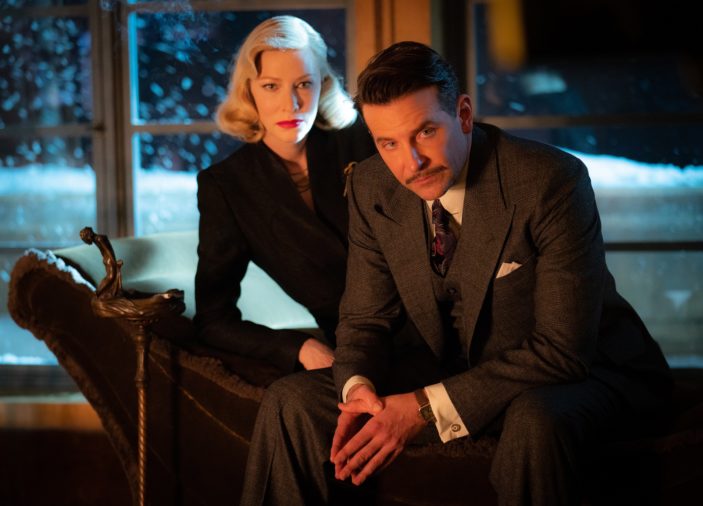
So intoxicatingly beautiful is Guillermo del Toro‘s haunting Nightmare Alley that its sheer aesthetic pleasures alone are enough to forgive the narrative sins it commits along the way.
Far from the unnerving horror film the trailers would have you believe, del Toro’s adaptation of William Lindsay Greshem‘s 1946 novel – first made into a feature in 1947 – submits to the occasional genre convention, but its noir mentality practically begs us to expect such tropes.
Detailing the psychological rise and fall of a tortured grifter, Nightmare Alley further supplies Bradley Cooper with the type of material that continually pushes him away from the traditional leading man archetype he so easily could have adhered to. Here he’s Stanton Carlisle who, after a fiery introduction (literally), finds himself at a carnival attraction – the Odd”i”torium, to be exact – somewhat entranced by the hustling lifestyle so many of the performers live by.
Clem Hoatley (Willem Dafoe) is the first higher-up that earns Stanton’s attention, swindling hard earned pennies from the crowds off the promise of providing them the view of a beastly man who he feeds live chickens to and speaks not of his origins. Within moments Stanton sees a future for himself amongst the trickery, taking his share of up-sleeved thievery from Clem but learning his truest schemes from supposed clairvoyant Zeena (Toni Collette) and her has-been mentalist husband (David Strathairn).
Though he is warned to not exploit such a gift as the one he has acquired from studying Zeena’s work, Stanton pays no mind – we wouldn’t expect him to either – and takes off to New York City where he makes a name for himself as a mentalist to the elite; his deception aided by carnival attraction “Elektra” (Rooney Mara), aka Molly, who absorbed large volumes of voltage night after night and took an instant liking to the charming Stanton who similarly ignored the warnings of Bruno (Ron Perlman), a Strong Man-type who threatened Stanton that should Molly be hurt in any way it would result in his own undoing.
Stanton’s ultimate affliction arrives in the form of Lilith Ritter (Cate Blanchett, perfecting the femme fatale archetype to a tee), a mysterious psychiatrist who leads him towards the wealthy Ezra Grindle (Richard Jenkins), a tortured soul who Stanton believes he can exploit for his own monetary value. The narrative del Toro and co-writer Kim Morgan opt to tell essentially gives the film a distinct two-act structure where each feels like an entirely different film. The carnival setting heavily juxtaposes the New York arc, and whilst some audience members may find themselves gravitating towards one half over the other – the running time of 150 minutes also leaning into Nightmare Alley‘s two film temperament – both are engaging acts without question.
The first half’s unusual setting is of benefit to the majority of players on hand, though, ironically, it’s when the story shifts to New York City that the true monsters are unleashed, with Jenkins and Blanchett both indulging in the villainous shades their characters are stroked with; Blanchett, particularly, enjoying herself as her Lilith toys with Stanton throughout, leading us as audiences to wonder just where her moral compass points.
Though Nightmare Alley isn’t necessarily the gothic horror film its title and marketing would have you believe, so audiences expecting something traditionally “scary” are best to find their thrills elsewhere, it’s a lush del Toro picture at the end of the day, one that’s meticulously crafted and wonderfully acted. Ultimately a picture detailing the horrors of humanity, Nightmare Alley is worth a visit for those ready to bathe in the indulgence of mature-aimed oddities and extravagance.
![]()
![]()
![]()
![]()
![]()
THREE AND A HALF STARS (OUT OF FIVE)
Nightmare Alley is screening in Australian theatres from January 20th, 2022
